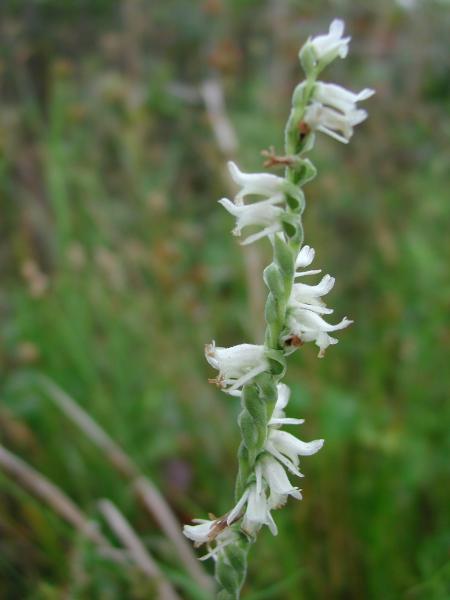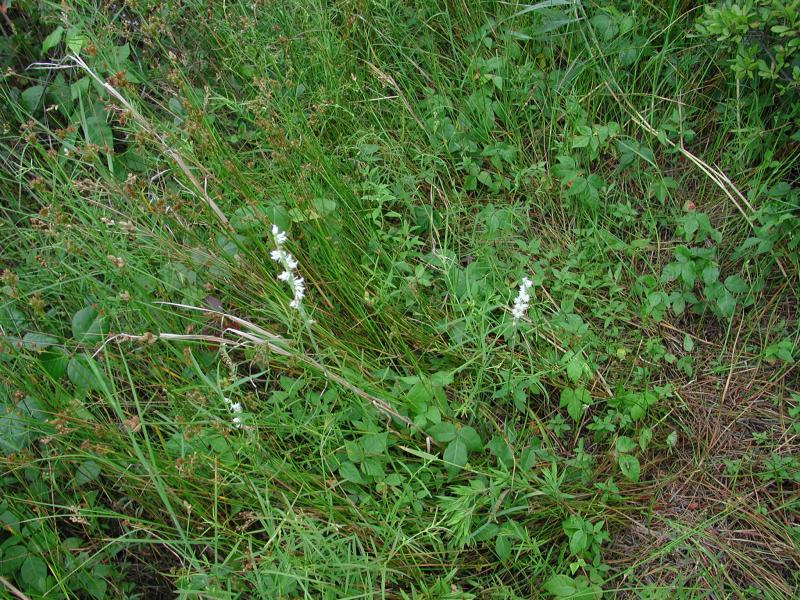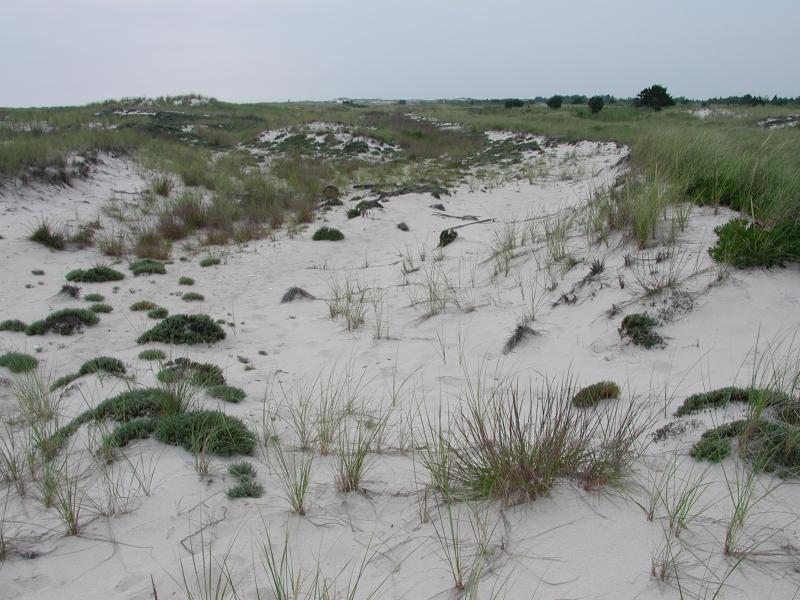Grass-leaved Ladies' Tresses
Spiranthes vernalis Engelm. & Gray
- Class
- Monocotyledoneae (Monocots)
- Family
- Orchidaceae (Orchid Family)
- State Protection
- Endangered
Listed as Endangered by New York State: in imminent danger of extirpation in New York. For animals, taking, importation, transportation, or possession is prohibited, except under license or permit. For plants, removal or damage without the consent of the landowner is prohibited.
- Federal Protection
- Not Listed
- State Conservation Status Rank
- S1S2
Critically Imperiled or Imperiled in New York - Especially or very vulnerable to disappearing from New York due to rarity or other factors; typically 20 or fewer populations or locations in New York, very few individuals, very restricted range, few remaining acres (or miles of stream), and/or steep declines. More information is needed to assign either S1 or S2.
- Global Conservation Status Rank
- G5
Secure globally - Common in the world; widespread and abundant (but may be rare in some parts of its range).
Summary
Did you know?
This orchid can grow twice as tall as any other ladies tresses orchid in New York. Even though it blooms in mid summer here, its species name means spring-blooming. This happened because it was originally described from the Southern United States where it blooms in the spring (Fernald 1950).
State Ranking Justification
There are eight existing populations, but only three of them have been seen in recent years. All except one of them have fewer than 100 plants each. There are 26 historical records known from the late 1800s through 1975 which need to be resurveyed to see if they still exist. Nine populations are now extirpated because their habitat has been destroyed.
Short-term Trends
The short-term trend of this orchid is unknown because there have not been enough recent surveys to determine whether the plants are still present at four of the known populations.
Long-term Trends
The long-term trend is strongly negative. It seems that there has been a severe decline in populations over the last 100 years. There were 35 known locations and nine of these have been confirmed extirpated. More survey work is needed at known sites older than 30 years to confirm this decline.
Conservation and Management
Threats
This orchid occurs in successional areas and the failure to maintain this habitat is a threat. A number of occurrences appear to be declining perhaps due to collecting.
Conservation Strategies and Management Practices
Maintain early-successional habitat for the existing populations through management with an appropriate disturbance regime.
Research Needs
More demographic studies are needed to track populations through time to understand yearly fluctuations in population size.
Habitat
Habitat
Maritime grassland with Andropogon scoparius, Danthonia spicata, Chrysopsis mariana and Aster paternus; disturbed grassland with Andropogon scoparius; sandpit with some areas but mostly overgrown with Andropogon scoparius, Solidago nemoralis, Solidago tenuifolia and Sorghastrum nutans; meadow with Drosera; grassy abandoned road in successional maritime forest; interdunal swales; meadow; moist sand; dry grassy ground; dry hills; edge of thicket; moist rocky hillside; cattail swamp; brackish meadow (New York Natural Heritage Program 2011). Dry to moist meadows, dune hollows, prairies, old fields, roadsides, cemeteries, lawns (FNA 2002). Open, sandy, moist or dry acid soil (Gleason & Cronquist 1991). Dry to moist siliceous, argillaceous or gravelly fields, clearings and swales (Fernald 1970).
Associated Ecological Communities
- Maritime beech forest*
(guide)
A hardwood forest with American beech as a dominant that usually occurs on north-facing exposed bluffs and the back portions of rolling dunes in well-drained fine sands. Wind and salt spray cause the trees to be stunted (average height 4 m to 15 m) and multiple-stemmed with contorted branches, especially on the exposed bluffs.
- Maritime dunes
(guide)
A community dominated by grasses and low shrubs that occurs on active and stabilized dunes along the Atlantic coast. The composition and structure of the vegetation is variable depending on stability of the dunes, amounts of sand deposition and erosion, and distance from the ocean.
- Maritime freshwater interdunal swales
(guide)
A mosaic of wetlands that occur in low areas between dunes along the Atlantic coast; the low areas (swales) are formed either by blowouts in the dunes that lower the soil surface to groundwater level, or by the seaward extension of dune fields. Water levels fluctuate seasonally and annually. Sedges and herbs are usually the most abundant types of plants. These wetlands may be quite small (less than 0.25 acre).
- Maritime grassland
(guide)
A grassland community that occurs on rolling outwash plains of the glaciated portion of the Atlantic coastal plain, near the ocean and within the influence of offshore winds and salt spray.
- Maritime heathland*
(guide)
A dwarf shrubland community that occurs on rolling outwash plains and moraine of the glaciated portion of the Atlantic coastal plain, near the ocean and within the influence of onshore winds and salt spray.
- Maritime pitch pine dune woodland*
(guide)
A maritime woodland that occurs on stabilized parabolic dunes. The substrate is wind and wave deposited sand that is usually excessively well-drained and nutrient poor. The community is subject to high winds, sand-blasting, salt spray, and shifting substrate.
* probable association but not confirmed.
Associated Species
- Chrysopsis mariana (Maryland golden-aster)
- Danthonia spicata (poverty grass)
- Euthamia caroliniana (slender flat-topped-goldenrod)
- Schizachyrium scoparium
- Solidago nemoralis
- Sorghastrum nutans (Indian grass)
- Symphyotrichum patens var. patens (common late purple-aster)
Range
New York State Distribution
This orchid is currently known from Suffolk County, Long Island with historical records to the west in Nassau County, Staten Island, and the Bronx. There is an unconfirmed report from Dutchess County.
Global Distribution
This orchid is widespread east of the short grass prairies but absent from Northern New England and with only scattered populations in the northern tier of states from South Dakota to Massachusetts.
Identification Comments
General Description
Spring Ladies-tresses is a perennial orchid species growing from numerous thick (up to 1 centimeter) roots. It has a cluster of 4 to 5 narrow, grass-like basal leaves, 1 cm wide and up to 25 cm long, the stem leaves are reduced to small bracts subtending the flowers. The single stem is densely covered with pointed, downy hairs, bearing flowers in a spiralling (or sometimes one-sided) infloresence 5 to 25 cm long.The flowers consist of an upper hood of 3 fused tepals, a lower lip consisting of a single tepal, and 2 lateral tepals. They are small (6-12 mm long and 2-3 mm wide) and white or cream-colored, with a yellow patch in the center of the lip (FNA 2002).
Best Life Stage for Proper Identification
Spiranthes vernalis is best identified when in flower.
Similar Species
The narrow, grass-like basal leaves and presence of dense, non-glandular hairs separate Spring Ladies' tresses from the seven other Spiranthes species in New York.
Best Time to See
The plant flowers from late July through August.
- Flowering
The time of year you would expect to find Grass-leaved Ladies' Tresses flowering in New York.
Grass-leaved Ladies' Tresses Images
Taxonomy
Grass-leaved Ladies' Tresses
Spiranthes vernalis Engelm. & Gray
- Kingdom Plantae
- Phylum Anthophyta
- Class Monocotyledoneae
(Monocots)
- Order Orchidales
- Family Orchidaceae (Orchid Family)
- Order Orchidales
- Class Monocotyledoneae
(Monocots)
- Phylum Anthophyta
Additional Common Names
- Spring Ladies' Tresses
Synonyms
- Ibidium praecox (Walter) House [Misapplied to New York specimens.]
- Ibidium vernale (Engelm. & A. Gray) House
- Spiranthes praecox (Walt.) S. Wats. [Misapplied to New York specimens.]
Additional Resources
Best Identification Reference
Flora of North America Editorial Committee. 2002. Flora of North America, North of Mexico. Volume 26. Magnoliophyta: Liliidae: Liliales and Orchidales. Oxford University Press, New York. 723 pp.
Other References
Brackley, F.E. 1985. The Orchids of New Hampshire. Rhodora 87:1-117. A85BRA01PAUS
Correll, D.S. 1950. Native Orchids of North America, North of Mexico. Chronica Botanica Company, Waltham, Mass. USA. B50COR01PAUS
Fernald, M.L. 1950. Gray's manual of botany. 8th edition. D. Van Nostrand, New York. 1632 pp.
Gleason, Henry A. and A. Cronquist. 1991. Manual of Vascular Plants of Northeastern United States and Adjacent Canada. The New York Botanical Garden, Bronx, New York. 910 pp.
Godfrey, R.K. Wooten, J.W. 1970. Aquatic and Wetland Plants of Southeastern United States. University of Georgia Press, Athens, GA. USA. B70GOD01PAUS
Henry, L.K., W.E. BUKER AND D.L. PEARTH. 1975. WESTERN PENNSYLVANIA ORCHIDS. CASTANEA 40 (2):93-171.
Holmgren, Noel. 1998. The Illustrated Companion to Gleason and Cronquist's Manual. Illustrations of the Vascular Plants of Northeastern United States and Adjacent Canada. The New York Botanical Garden, Bronx, New York.
Luer, C.A. 1975. The Native Orchids of United States and Canada Excluding Florida. B75LUE01PAUS
Mitchell, Richard S. and Gordon C. Tucker. 1997. Revised Checklist of New York State Plants. Contributions to a Flora of New York State. Checklist IV. Bulletin No. 490. New York State Museum. Albany, NY. 400 pp.
New York Natural Heritage Program. 2010. Biotics database. New York Natural Heritage Program. New York State Department of Environmental Conservation. Albany, NY.
New York Natural Heritage Program. 2024. New York Natural Heritage Program Databases. Albany, NY.
Reschke, Carol. 1990. Ecological communities of New York State. New York Natural Heritage Program, New York State Department of Environmental Conservation. Latham, NY. 96 pp. plus xi.
Sheviak, C.T. 1974. An Introduction to the Ecology of the Illinois Orchidaceae, Illinois State Museum Scientific Papers XIV, Springfield, IL, U.S.A. B74SHE01PAUS
Stuckey, I.H. 1967. Environmental Factors and the Growth of Native Orchids. American Journal of Botany, 54:232-241. A67STU01PAUS.
Voss, E.G. 1972. Michigan Flora, Part I. Gymnosperms and Monocots. Cranbrook Institute of Science Bulletin 55 and the University of Michigan Herbarium. Ann Arbor. 488 pp.
Weldy, T. and D. Werier. 2010. New York flora atlas. [S.M. Landry, K.N. Campbell, and L.D. Mabe (original application development), Florida Center for Community Design and Research http://www.fccdr.usf.edu/. University of South Florida http://www.usf.edu/]. New York Flora Association http://newyork.plantatlas.usf.edu/, Albany, New York
Links
About This Guide
This guide was authored by: Stephen M. Young
Information for this guide was last updated on: October 24, 2022
Please cite this page as:
New York Natural Heritage Program. 2024.
Online Conservation Guide for
Spiranthes vernalis.
Available from: https://guides.nynhp.org/spring-ladies-tresses/.
Accessed July 27, 2024.


